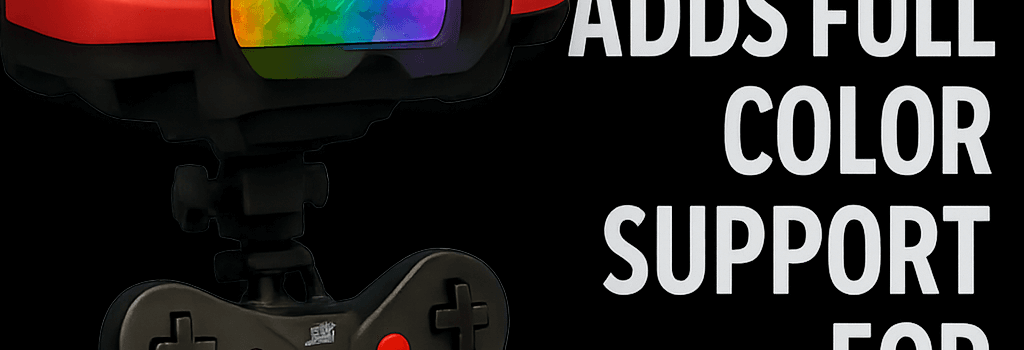Red Viper Emulator Adds Full-Color Support for Virtual Boy

Bringing Nintendo’s 90s Experiment to Vibrant Life
When Nintendo shipped the Virtual Boy in 1995, its distinctive red-on-black stereoscopic display was both a selling point and a severe limitation. Fast-forward three decades, and the homebrew community has found a way to transcend that constraint. The latest version of Red Viper, a Virtual Boy emulator for the Nintendo 3DS, introduces a full 16-bit color remapping mode—beyond the traditional red tones—breathtakingly revitalizing titles like Wario Land, Jack Bros., and homebrew Mario Kart clones.
Why Color Matters: From LED Limitations to Modern Displays
Hardware Constraints of the Original Virtual Boy
- Resolution: Dual 384×224 monochrome LED panels (1-bit per pixel).
- Color: Single-wavelength red LEDs, chosen for cost and availability in the mid-90s.
- Graphics Pipeline: Simple tile and sprite renderer with minimal palette registers.
- System-on-Chip: NEC uPD77xx core at 20 MHz, 1 KB VRAM per eye.
Those specs explain why Nintendo’s engineers were limited to four intensities of red: “Darkest,” “Dark,” “Light,” and “Lightest.” Gamers at the time appreciated the immersive parallax effect, but the lack of chromatic variety aged poorly compared to the Game Boy’s grayscale.
Color Mapping Techniques in Emulation
Modern emulators overcome hardware limits with software shaders that reinterpret per-pixel intensity values. Red Viper’s “Multicolor” mode maps each of the four original shade indices to arbitrary RGB values, allowing:
- True 24-bit color assignment via a user-configurable color picker.
- Real-time brightness and saturation sliders for fine-tuning.
- Optional dithering algorithms (ordered or Floyd–Steinberg) to simulate smooth gradients.
Under the Hood: How Red Viper Implements Multicolor Mode
Red Viper leverages libctru on the 3DS to access the GPU’s shader cores. A custom GLSL-like fragment shader intercepts each pixel’s depth and shade index, applies the user’s color lookup table (CLUT), and outputs the new RGB triplet. Key technical details:
- Palette Memory: Emulated as a 4×24-bit CLUT stored in 3DS’s VRAM bank C.
- Shader Pipeline: A minimal vertex pass-through and fragment conversion optimized to ~300–400 cycles per fragment on the 268 MHz PICA200 GPU.
- Performance Impact: Frame rates drop by 5–10% in multicolor mode versus monochrome, still comfortably above 50 fps.
- Battery Life: 15–20% additional drain due to higher GPU usage, mitigated by optional “Low-Power Dither” mode.
3DS Stereoscopic Emulation & Display Filtering
Red Viper continues to preserve Virtual Boy’s signature parallax depth by rendering each eye’s view to the 3DS’s top LCD and bottom parallax panel. The built-in “NVL Mode” filter emulates the VB’s red LED glow, but users can disable it to display fully saturated colors directly.
Homebrew Scene Revitalized
Beyond official games, the Virtual Boy homebrew community has produced ports of Street Fighter II, Super Mario Bros. 3, and original titles like Fish Polo and the hamburger-shooter Burgertime VB. Full color support has immediate benefits:
- Enhanced readability: Green turtles no longer blend into black backgrounds.
- Improved aesthetics: Space shooters gain depth with subtle nebula-blue stars.
- Gameplay clarity: Puzzles and HUD elements stand out when color-coded.
Expert Insights: Developer Interviews and Community Feedback
“Our goal was to honor the original hardware while giving players new ways to experience these titles,” says lead developer Martin “ViperDev” Erickson. “By exposing a flexible CLUT in the settings menu, we empower users to create palettes that fit each game’s mood.”
RetroArch maintainer Libretro dev ‘slash’ recently merged a similar shader into the mainline repository, enabling desktop and mobile colorized VB emulation across hundreds of cores. According to community benchmarks, colorized RetroArch builds on a mid-range PC achieve >90 fps at 1080p.
Future Prospects and Official Solutions
While Red Viper remains a homebrew project, rumors swirl that Nintendo’s patents on stereoscopic displays and LED arrays may see a revival—possibly integrated into a modern VR headset. Meanwhile, emulation platforms like Mednafen are planning official support for indexed palette overrides in upcoming 1.30 releases.
Whether through enhanced emulators or future hardware, the Virtual Boy’s legacy continues to evolve. For now, Red Viper offers both longtime enthusiasts and curious newcomers a colorful gateway into one of gaming’s most unusual chapters.
“Color gave me a reason to replay Wario Land. It’s like rediscovering the artistry behind every pixel,”